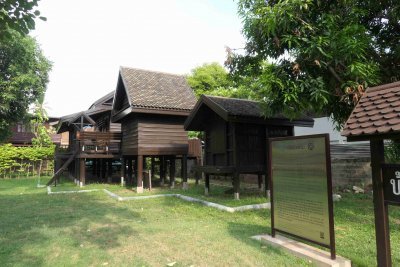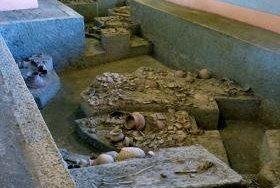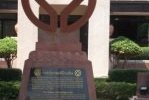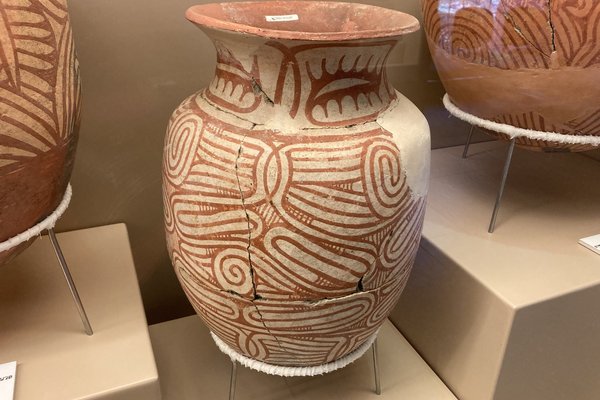Thailand
Ban Chiang
Ban Chiang is considered the most important prehistoric settlement discovered in South-East Asia.
When this mound was discovered in 1966, it attracted enormous publicity due to its attractive red-painted pottery. The first scientific excavation uncovered several skeletons together with bronze grave gifts. Rice fragments have also been found, which prove that the Bronze Age settlement was made by farmers and it marks the beginnings of settled agricultural communities in the region.
Community Perspective: a visit is centered around the Ban Chiang National Museum, which very well displays all discoveries in the area and there is a second area accessible inside a Buddhist temple that holds a smaller archaeological site. Timonator even discovered a third (overgrown) site within the town of Ban Chiang. Solivagant goes into detail about the controversial dating history of the site that continues to confuse scholars and travel guides.
Site Info
Official Information
- Full Name
- Ban Chiang Archaeological Site (ID: 575)
- Country
- Thailand
- Status
-
Inscribed 1992
Site history
History of Ban Chiang
- 1992: Inscribed
- Inscribed
- 1991: Referred
- Bureau - pending more study of Ban Chiang and comparative studies of similar sites
- Type
- Cultural
- Criteria
- iii
Links
- UNESCO
- whc.unesco.org
- Official
-
- tourismthailand.org — Tourism Thailand Ban Chiang
- Related
-
- travelfish.org — Visitor information by Travelfish
All Links
UNESCO.org
- whc.unesco.org — whc.unesco.org/
Official Website
- tourismthailand.org — Tourism Thailand Ban Chiang
Related Resources
- travelfish.org — Visitor information by Travelfish
News Article
- Nov. 30, 2024 theartnewspaper.com — US authorities return four artefacts from Ban Chiang archaeological site to Thailand
- March 8, 2015 bangkokpost.com — Ban Chiang artefacts coming home
Community Information
- Community Category
- Archaeological site: Prehistoric
Travel Information
Recent Connections
-
Incorrect UNESCO 'Number of locations'
UNESCO does not show a split in locatio… -
Built in the 3rd Millennium BC
"Reanalysis by radiocarbon dating sugge… -
Recorded cultural discoveries
In August 1966, by Steve Young, a poli…
Connections of Ban Chiang
- History
-
-
Neolithic age
" presenting a full picture of the emergence of a settled agrarian way of life in the early Neolithic period in Southeast Asia" (official description UNESCO website) -
Iron Age
"the most recent graves date to the Iron Age" (wiki) -
Bronze Age
"In addition to ceramics, the site has exceptional and uniquely early evidence of the knowledge of bronze-making by its inhabitants with remains of raw materials, production facilities, and complete bronze tools and ornaments. These early bronze finds make the site known as the metal tools production site in East and Southeast Asia" (official description at UNESCO website)
-
- World Heritage Process
-
-
Inscribed on a single criterion only
iii. to bear a unique or at least exceptional testimony to a cultural tradition or to a civilization which is living or which has disappeared -
Incorrect UNESCO 'Number of locations'
UNESCO does not show a split in locations and the AB ev also does not hint on it, but the map shows 2 core zones with 1 buffer zone.
-
- Human Activity
-
-
Residential burials
"This site has often been called "the cemetery site", but research has suggested that the deceased were buried next to or beneath dwellings. This practice is called residential burial" (Wiki)
-
- Constructions
-
-
Cemeteries
"The 1974 excavation of Ban Chiang revealed Bronze Age graves over a Neolithic cemetery,.." -
Protective Shelters
"The Ban Chiang excavation site is protected from damage with a secured shelter. " (official description UNESCO website)
-
- Timeline
-
-
Built in the 3rd Millennium BC
"Reanalysis by radiocarbon dating suggested that a more likely date for the earliest metallurgy at Ban Chiang was c. 2000–1700 BCE. A date of 2100 BCE was obtained from rice phytoliths taken from inside a grave vessel of the lowest grave, which had no metal remains. The youngest grave was about 200 CE. Bronze making began circa 2000 BCE, as evidenced by crucibles and bronze fragments" (wiki)
-
- Science and Technology
-
-
Recorded cultural discoveries
In August 1966, by Steve Young, a political science student from the US who was living in the village for his thesis.See en.wikipedia.org
-
- Visiting conditions
-
-
Foreigner prices
30B Thai/150B Foreigners
-
News
- theartnewspaper.com 11/30/2024
- US authorities return four artefac…
- bangkokpost.com 03/08/2015
- Ban Chiang artefacts coming home
Recent Visitors
Visitors of Ban Chiang
- AC
- Aitia
- Alejandro Lau
- Alex Goh
- Atila Ege
- Bernard Joseph Esposo Guerrero
- Boj
- Christravelblog
- CynthiaSam
- Dagmara
- David Marton
- Dimitar Krastev
- Els Slots
- Errol Neo
- Fan Yibo
- Frederik Dawson
- Gary Arndt
- GeorgeIng61
- GerhardM
- henryjiao18
- Iain Jackson
- Ivan Rucek
- Jana and Matt
- Joel on the Road
- Jonoprout
- Joyce van Soest
- Justin Rickey
- KarenBMoore
- Loic Pedras
- Luis Filipe Gaspar
- Luke LOU
- Maciej Gowin
- Martina Rúčková
- Michael Ayers
- Mikko
- Milan Jirasek
- MMM
- Nihal Ege
- pete_simms
- Philipp Peterer
- Randi Thomsen
- Sergio Arjona
- Shandos Cleaver
- sncjob
- Solivagant
- Stanislaw Warwas
- Svein Elias
- SymonMajewski
- Szucs Tamas
- Taotao Chen
- Thanneermalai L
- Thomas Buechler
- Thomas van der Walt
- Timonator
- Vanessa Buechler
- Vincent Cheung
- Xiquinho Silva
- Yongcheng Liu
- Zach
- Zoë Sheng
- Zos M
Community Reviews
Show full reviews
The worldheritagesite in Ban Chiang relates to the remains of the Ban Chiang culture that was named after the village that developed on the site where the ancient culture has lived around 200 years ago when settlers moved there from the territory that is today Laos. The site is famous for the pottery which was most famously used for burial rituals and that can be split into three time intervals between around 5,000 years ago and 2,000 years ago. Additionally remains of bronze and iron processing have been found often next to skeletons. We have visited the three components that are presented in the leaflet available in the national museum of Ban Chiang. The museum is the most interesting component however it´s only in the buffer zone as in this area no burial remains have been found. It was dedicated to the archaeology by the king when he visited the excavation sites in 1972 and was supposed to support the national understanding of the origin of the Thai people or generally the people of the region. The first room is at the end of the museum, so you have to walk through the whole exhibition and in the end climb up one level to the room that is dedicated to the visit of the king. There is a lot of emphasis on the visit by the king and his questions that he asked to the archaeologists. In other countries the presentation of his visit would probably be seen as exaggerated …
Keep reading 0 comments
Oh, how I love WHS like Ban Chiang (BC) - It may not offer iconic monuments but it is relatively infrequently visited and uncrowded and covers a lesser known but interesting/significant historical period/culture. It also has plenty of “issues” regarding its inscription and recent history together with opportunities for “post-visit investigation”!! At the time of its discovery in 1966, BC experienced world-wide fame as the cradle of a “newly discovered civilisation” which had independently developed its own bronze making technology. This was followed by archaeological controversy and revision of timescales. Meanwhile its treasures suffered looting - leading to international action to try to recover them. As a result, its pottery artefacts fill private collections Worldwide and grace musea in USA, London and Berlin.
I report (at some length!!) on some of the “issues” below in the light of our visit in Nov 2017. Press articles from the period give a flavour of the excitement which initial assessments of the place of BC in World history engendered. NYT (Jun 8 1975) - “If dates indicated by recent technical analysis are correct for BC pottery then, by inference, the bronze found in the same graves was made in 4500BC too and that’s 1500 years earlier than anyone ever expected it could be made and in a part of the World where no one ever expected to find metallurgical practices at such an early time”. See - this article. Similarly, this Washington Post article of Sep 8 1975.
…
Keep reading 0 comments
We visited the Ban Chiang National Museum in January 2016. This archaeological museum is located ca. 50 km east of Udon Thani, the provincial capital.
It is a wonderful museum with a great exhibition. All items on display are described with labels in Thai and in English. The presentation is excellent.
We recommend you set aside at least two hours to go through the exhibition. There is a lot to see and to learn here.
Unfortunately, I have to add two negative points in this review:
(1) The museum uses double pricing. Thai citizens may enter for 30 TB, while foreigners must pay 150 TB. Foreigners have to pay five times more than Thais! How can the museum think that this makes the foreign visitor feel welcome?
(2) The museum has produced a guidebook about the collections. The book is available in Thai and in English. The price is 100 TB. We could see the books in a glass counter opposite the counter where you buy the tickets to enter the museum. But it was not possible to buy the guidebook! Why not? We were told that the member of staff who has the key to the glass counter was not at work on that day.
So they have the book and we could see the book, but it was impossible to buy it, because the person with the key was not present! The person who sold the tickets did not care. She just said: "No staff today."
How can …
Keep reading 0 comments
To reach Ban Chiang I took a bus travelling from Udon Thani to Nakhon Phanom which dropped me at the turn-off for the village. Here several tuktuks were lined up awaiting potential customers, so I hired one to travel the 6 km to the National Museum. This brand new building housed a plethora of information, not only about the Ban Chiang excavations but also about life in the region thoughout the ages.
Afterwards I walked the 500 metres to one of the excavation sites, located in the courtyard of the Wat Pho Sri temple. This site was slightly underwhelming, and would have been quite meaningless had I not visited the museum first.
Keep reading 0 comments
Beneath the soil of the village of Ban Chiang in Northeastern Thailand is where one of the oldest Bronze Age civilizations discovered in Asia with its unique designed potteries which can be found in many important museum in Europe; however, the site itself maybe the least visited WHS in this country. My visit to Ban Chiang happened while I was on my way to Laos and stopped at Udonthani which is the nearest city to Ban Chiang Village.
Just only 45 minute from Udonthani, I was at the village of Ban Chiang, the village was quite large and located on the big hill and decorated with many supersize reproductions of Ban Chiang potteries. The archeological site itself was divided into 2 areas, which I visited them both. The first area was the Ban Chiang National Museum; the museum itself was very well displayed of all discoveries in the area especially from the main archaeological sites behind the museum. From the museum I went to the second area, this area was located inside the Buddhist temple with smaller archaeological site showing many skeletons of ancient people and countless potteries.
I had to admit that I had no idea how to compared Ban Chiang with other archaeological site as this place is quite totally different from other archaeological site I had visited, small but very interesting, and its potteries were really beautiful. This humankind civilization was really unique that have to be seen and admired on. Ban Chiang,in my opinion, another great …
Keep reading 0 comments
My wife and I visited Ban Chiang on 1/11/04. The directions to the museum were a little bit unclear, and to the excavation site, they were non-existent - at least in English. The new buildings were under construction for the new museum facility. The exhibits were those for the traveling exhibit. These were still very good exhibits. We hope to be able to go to the site again when the new buildings are open. We visited this web site because there was no information available at the museum for us that would provide more extensive information that had been part of the exhibit. It would be very helpful if something additional could be offered for sale that covers the subject more and provides photos. We found publications at other archeological sites, such as Wiang Kum Kam, Ayuthaya, etc.
The excavation pit had been undergoing some work as well. Many bags [of archeological materials?] were stacked on the side of the excavation pit and some access to viewing the site was barricaded. Some of the skeletal materials and ceramics could still be seen in the side walls. The profiles had not been cleaned recently, so the profiles were difficult to see, but some detail was evident.
As an archeologist, I truly hope the excavation site becomes more prepared for interpretation for the public for their education. This is a very important site and needs more public awareness and exposure to both Thai people and foreign visiters. Few tour books highlight this …
Keep reading 0 comments
